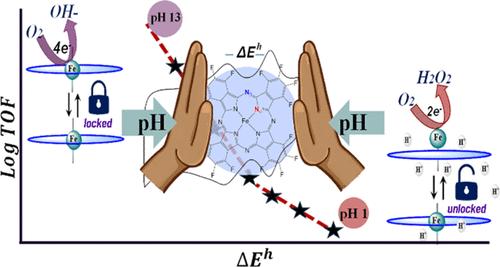全氟酞菁铁对氧还原反应的电催化活性及电化学硬度作为反应性描述符的实验与理论研究
IF 13.1
1区 化学
Q1 CHEMISTRY, PHYSICAL
引用次数: 0
摘要
全氟酞菁铁16(F)FePc可能是目前报道的在碱性介质中促进氧还原反应(ORR)的活性最高的MN4分子催化剂。它的高活性归因于氟取代基的吸电子性质,这促进了硬铁活性位点与硬氧分子相互作用。然而,对其活动的探索还很浅。在这里,我们用16(F)FePc修饰了边缘平面热解石墨表面(EPG),以促进不同pH介质中的ORR,并构建了Pourbaix图作为16(F)FePc的电催化路线图。此外,最近提出的ORR反应性描述子,即“电化学硬度”(ΔEh),在不同ph值的EPG/16(F)FePc体系中进行了测定。结果发现,催化剂的反应性与ΔEh值成反比,因此小的值会导致高活性。氧化还原硬度(η - ox-red)参数也得到了相同的行为,该参数是通过DFT计算在理论上确定的。理论η - ox-red表明,随着16(F)FePc中氮原子质子化的增加,Fe(II)的反应性降低,支持ph依赖性ΔEh值。此外,确定了16(F)FePc的ph依赖锁定/解锁机械开关行为,这归因于铁中心在n4平面以上的运动而没有脱金属过程。我们利用电化学技术和表面增强拉曼光谱(EC-SERS)在酸性介质中观察了这一现象,监测了Fe(II)/(I)、Fe(III)/(II)氧化还原电位,以及原位ORR过程。基于扫描隧道显微镜的断结技术(STM-BJ)揭示了这种单分子水平的机械开关。相反,机械开关在碱性介质中被锁定,16(F)FePc对ORR处于非催化状态。因此,未锁定的机械开关可以解释16(F)FePc在酸性介质(非催化状态)中较低的ORR催化活性。这些发现对于理解16(F)FePc的催化行为,特别是在酸性介质中的催化行为至关重要。本文章由计算机程序翻译,如有差异,请以英文原文为准。

The On/Off pH-Dependent Electrocatalytic Activity of the Perfluorinated Iron Phthalocyanine for the Oxygen Reduction Reaction and Electrochemical Hardness as a Reactivity Descriptor: Experimental and Theoretical Study
Perfluorinated iron phthalocyanine 16(F)FePc is probably the most active MN4 molecular catalyst reported to promote the oxygen reduction reaction (ORR) in alkaline media. Its high activity is attributed to the electron-withdrawing properties of the fluoro substituents, which promote a hard-iron active site to interact with a hard-O2 molecule. However, its activity has been explored shallowly. Here, we modified an edge plane-pyrolytic graphite surface (EPG) with 16(F)FePc to promote ORR in different pH media to build a Pourbaix diagram as an electrocatalytic roadmap for 16(F)FePc. Furthermore, the recently proposed reactivity descriptor for ORR, known as the “electrochemical hardness” (ΔEh), was determined in the EPG/16(F)FePc system at different pH. It was found that the catalyst’s reactivity is inversely proportional to the ΔEh values, so small values conduct to high activity. The same behavior was obtained for the oxidation–reduction hardness (ηox-red) parameter, which was theoretically determined in this work by DFT calculations. The theoretical ηox-red suggests a decrease of the Fe(II) reactivity with the increase of nitrogen atom protonation in the 16(F)FePc, supporting the pH-dependent ΔEh values. Moreover, a pH-dependent locked/unlocked mechanical switch behavior for the 16(F)FePc was determined, attributed to the iron center motion above the N4-plane without a demetalation process. We observed this phenomenon in an acid media using electrochemical techniques coupled with Surface-Enhanced Raman Spectroscopy (EC-SERS), monitoring the Fe(II)/(I), Fe(III)/(II) redox potentials, and the in situ ORR process. The scanning tunneling microscopy-based break junction technique (STM-BJ) revealed this mechanical switch at the single-molecule level. Conversely, the mechanical switch is locked in alkaline media, and the 16(F)FePc is in an on-catalytic state for ORR. Therefore, the unlocked mechanical switch could explain the low ORR catalytic activity of the 16(F)FePc in acidic media (off-catalytic state). These findings are crucial for understanding the catalytic behavior of 16(F)FePc, especially in acid media.
求助全文
通过发布文献求助,成功后即可免费获取论文全文。
去求助
来源期刊

ACS Catalysis
CHEMISTRY, PHYSICAL-
CiteScore
20.80
自引率
6.20%
发文量
1253
审稿时长
1.5 months
期刊介绍:
ACS Catalysis is an esteemed journal that publishes original research in the fields of heterogeneous catalysis, molecular catalysis, and biocatalysis. It offers broad coverage across diverse areas such as life sciences, organometallics and synthesis, photochemistry and electrochemistry, drug discovery and synthesis, materials science, environmental protection, polymer discovery and synthesis, and energy and fuels.
The scope of the journal is to showcase innovative work in various aspects of catalysis. This includes new reactions and novel synthetic approaches utilizing known catalysts, the discovery or modification of new catalysts, elucidation of catalytic mechanisms through cutting-edge investigations, practical enhancements of existing processes, as well as conceptual advances in the field. Contributions to ACS Catalysis can encompass both experimental and theoretical research focused on catalytic molecules, macromolecules, and materials that exhibit catalytic turnover.
 求助内容:
求助内容: 应助结果提醒方式:
应助结果提醒方式:


